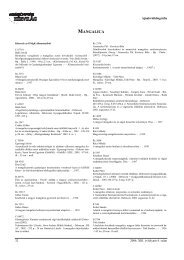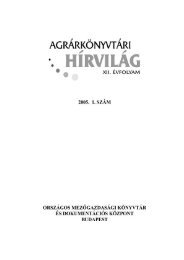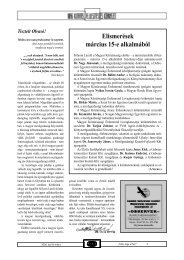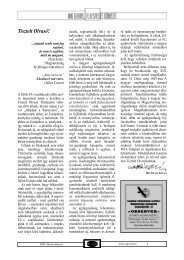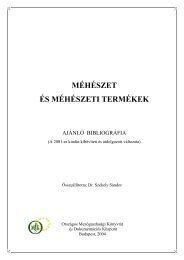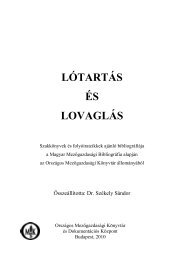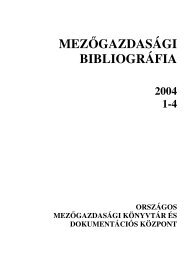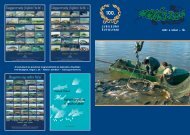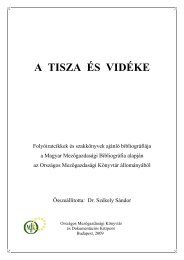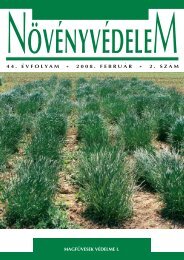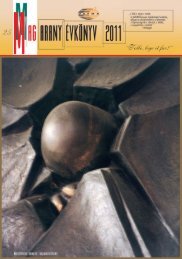hUNGARiAN AGRicUltURAl RESEARch
hUNGARiAN AGRicUltURAl RESEARch
hUNGARiAN AGRicUltURAl RESEARch
You also want an ePaper? Increase the reach of your titles
YUMPU automatically turns print PDFs into web optimized ePapers that Google loves.
Irma Orova 1<br />
Bass and ARIMA Models in New Product<br />
Forecasting with Applications<br />
New product forecasting is an<br />
important topic both in production<br />
and marketing. This study<br />
provides a brief summary of the<br />
new product forecasting objectives<br />
and techniques. The deterministic<br />
Bass (1969) model is widely<br />
influential in marketing and<br />
management science since the<br />
model parameters characterise the<br />
diffusion process and support the<br />
comparison of different products<br />
and countries as well. The<br />
application of the stochastic<br />
ARIMA models is quite new in<br />
this field. The spread of a new<br />
Hungarian product was investigated<br />
using the Bass and ARIMA<br />
models on representative sales<br />
data. Bass model parameters were<br />
determined on monthly, quarterly<br />
and annual data both by OLE and<br />
NLLS regressions. Difference was<br />
found in the Bass parameters:<br />
NLLS regression gave 75% lower<br />
values in average for the<br />
innovation parameters of the OLS<br />
regression results. NLLS<br />
regression gave the better quality<br />
of fitting according to the square<br />
of the Pearson product moment<br />
correlation coefficients of the<br />
fittings (0,84 on average contrary<br />
to the 0,55 average value of the<br />
OLE regression). Results inspire<br />
the importance of the reference of<br />
the scale of the time series and the<br />
regression method in publishing<br />
the Bass parameters. SARIMA<br />
(2,1,2)(0,12,0) empirical model<br />
provided the best fit on the time<br />
series. As the life-time of the<br />
products decrease, the short term<br />
forecast by the ARIMA holds<br />
greater importance in the future.<br />
New products spread on the<br />
market and assure profit for the<br />
companies. Research indicates that<br />
70% of today’s manufactured<br />
goods will be obsolete in six years.<br />
Twenty-six percent of revenue at<br />
engineering companies is earned<br />
from products less than three years<br />
old. Companies with strong<br />
(enabling) R&D strategies are 73%<br />
more profitable (Singh). Thus new<br />
product forecasting is an important<br />
topic both in the production and<br />
marketing perspectives. The<br />
limited amount of data for the<br />
analysis, the inability to fully<br />
capture market complexity, market<br />
penetration rate, are some of the<br />
special difficulties of the new<br />
product forecasting (Kahn, 2006).<br />
New product is a form of<br />
innovation. “Innovation is an idea,<br />
a practice, or an object that is<br />
perceived as new by an individual<br />
or other unit of adoption” by<br />
Rogers (2003), one of the first<br />
researchers of the spread of<br />
innovation.<br />
In the other words, Kahn<br />
(2006), who investigate new<br />
product forecasting in the view of<br />
knowledge management says, that<br />
“product can describe any<br />
company offering: product, service,<br />
idea, because these are intertwined<br />
in our time”.<br />
Different types of new products<br />
exist: cost improvement, product<br />
improvement, line extensions,<br />
market extensions, new uses, new<br />
category entry, new-to-the-world.<br />
Forecasting objectives are of<br />
level, time horizon, interval and<br />
form (Kahn, 2006).<br />
New Product Forecasting<br />
Techniques<br />
Kahn (2006) sorts forecasting<br />
techniques into three groups:<br />
qualitative, market research and<br />
quantitative techniques. This work<br />
deals with two quantitative<br />
methods a) deterministic diffusion<br />
model and b) stochastic time series<br />
models.<br />
“Diffusion is the process by<br />
which an innovation is communicated<br />
through certain channels<br />
over time among members of a<br />
social system” by Rogers, the<br />
founder of the Diffusion of<br />
Innovations Theory. Rogers<br />
furthers Tarde’s “laws of imitation”<br />
and says: “most innovations have<br />
an S-shaped rate of adoption”<br />
regarding the cumulative adoptions<br />
or sales during the time on more<br />
than 200 observations (Rogers,<br />
2003).<br />
The first purchase Bass (1969)<br />
model is a very influential<br />
mathematical model in marketing<br />
and management science.<br />
Innovators buy by the mass-media<br />
mechanism and the imitators by<br />
word-of mouth in this model,<br />
basing on Rogers’ Diffusion of<br />
Innovations Theory. It is the only<br />
diffusion model that gives not only<br />
excellent forecasts (even on few<br />
data), but it gives model parameters<br />
(innovation and imitation) that<br />
characterize the diffusion process<br />
1Szent István University Gödöllô Hungary, orova.laszlone@gek.szie.hu<br />
Hungarian Agricultural Research 2009/3–4 31



